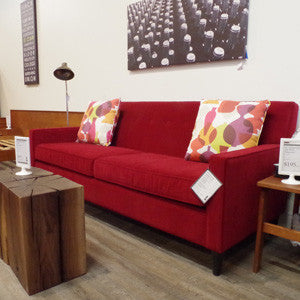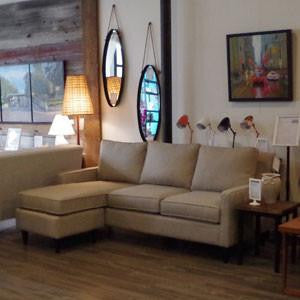How to Buy a Sofa—Five Steps for Doing It Right
In most homes, sofas are high traffic pieces of furniture. When buying a sofa, you want to make sure you’re getting something that can stand up to heavy use for many years to come. Here are five steps you can take to be successful at sofa shopping.
Step one: get out your measuring tape and notepad.
You’ve got some work to do. Before thinking about anything else, be sure to measure:
- Every doorway the sofa will pass through on the way to its final destination. The door of your house is, of course, the first, but you also need to consider other doorways along the way. Is your new couch destined for a spare bedroom, home office, or den? Measure the height and width of all doors so you know what size of sofa to look for.
- All stairways. Will your new sofa fit through that tricky corner in your basement stairs? Will you be able to stuff it up the stairway to your spare bedroom? Don’t wait until it’s in your hands to find out. Measure the height, width, depth, and diagonal space in all stairways.
- The space where your sofa will sit. This measurement involves more than the length of the sofa, although that is important. (In addition to the length of the room, think of your length. If you plan to stretch out, be sure you calculate the length you need between the arms of the sofa to ensure maximum comfort.) If you have a sofa table or large piece of artwork on the wall where the sofa will be placed, be sure to measure the space so you have an ideal sofa height in mind. There can be quite a variation. Consider that our vintage sofas tend to be in the 28”-29” range in height, while our custom sofas can go from 33” to 37” high. A sofa of the wrong height can throw off the proportions of your space so take care with this measurement.
- The maximum depth of all components of the sofa. Chaises are really popular right now and for good reason—they add considerable comfort and seating space. Before opting for a chaise, take accurate measurements of your room to ensure you have enough depth. You don’t want to be squeezing around it or whacking your knee on it every time you try to move through the room. A visual aid is helpful here. Lay out some newspapers on the floor to the maximum size you can reasonably fit and use that as a template for buying. Consider seat depth as well. Deeper seats can look inviting and are great for naptime, but they may not be as comfortable for sitting—think strained backs or legs sticking out awkwardly instead of bending gracefully over the sofa cushion.
Step two: educate yourself about the construction of sofas.
Yes, this sounds frightfully boring but you won’t regret it. To ensure you are getting good value for your money, you need to know what is inside a sofa. If you have a general idea about things like frames and springs, you’ll know how to interpret the information your salesperson provides. Here are a few things to consider:
- For frames, kiln-dried hardwood is the best option. Drying prevents warping and and hardwoods are just more durable than softwood, metal frames, or particle board. (Vintage sofas tend to be made of hardwood so there are fewer worries there when it comes to construction. Never hurts to ask though.)
- Joinery is another critical element. Here we borrow from our friends at Brentwood Classics: “double doweled stress points, hardwood corner blocks, screwed and glued at points of stress where applicable.” You may not know what all of this means, but you at least you’ll know which qualities to look for.
- For cushions, you need to look into the density of the foam—higher density means a cushion will hold its shape longer. And for springs, web and coil or sinuous systems are best. (When you actually get to shopping, Good Housekeeping recommends that you sit on the corner or outside edge of a sofa and listen for squeaks or creaks, both of which signal incorrect placement and, likely, inferior quality.)
- And, very importantly, find out if the legs can be removed. Those extra few inches could make a huge difference when sofa meets doorway.
Step three: consider colour and fabric.
When thinking about colour, ask yourself who will be using your couch: pets, kids, accident-prone friends, messy relatives? If you said yes to any of those, you may want to avoid white or even lighter shades altogether. Black couches can also show pet hair and some stains. Consider grey—we have more than 50 shades in our custom sofas—or a pattern. If you want your sofa to be a focal point, a bold colour, as shown below, is also a great option. Take a good look at your room and the accessories you already have then look online to see what’s trending in upholstery. You can also visit stores, like VHB, to see and feel the fabrics on offer.
Fabrics should be durable and you should know your options for cleaning them before buying. Do you want a fabric that is vacuum-only or dry-clean only, or something that can be scrubbed a little in case of spills? What about leather instead of a textile?
Factor the amount of maintenance required with any potential sources of damage to gauge whether the fabric fits your lifestyle, perhaps with questions like these: Will Kitty’s claws tear up your beautiful woven pattern? Does red wine stain taupe leather? Will you damage the fabric scrubbing out the butter from your movie night popcorn?
Speaking of stains, you may want to inquire about stain guards. Although very popular, the Scotchgard brand is also very toxic. Our Brentwood sofas are available in a wide selection of Crypton fabric, the latest innovation in Greenguard Gold Certified non-toxic upholstery fabric that resists stains and spills.
Step four: sit down and ask questions.
Once you have a general idea about what you want in a sofa, it’s time to visit your local store and put a few sofas through their paces. Sit on each model you are considering to see how they feel. Listen for squeaks, as we noted above, but also try to get a sense of the firmness of the cushioning. And ask the salesperson all the questions you prepared in steps two and three. If he or she can’t answer you, ask to see the manufacturer’s specifications.
Step five: read the fine print.
Before swiping your credit card, ask about warranties in workmanship and construction and care and cleaning (as noted above). Our Brentwood Classics custom sofas offer an industry leading lifetime warranty on frames and springs, 5-year warranty on cushion cores, and 1-year warranty on fabrics and leathers. And the fact that they are made right here in Toronto means you will get repair service directly from the manufacturer, not from a third-party tradesperson hired by a distant company.
Happy shopping!






Leave a comment